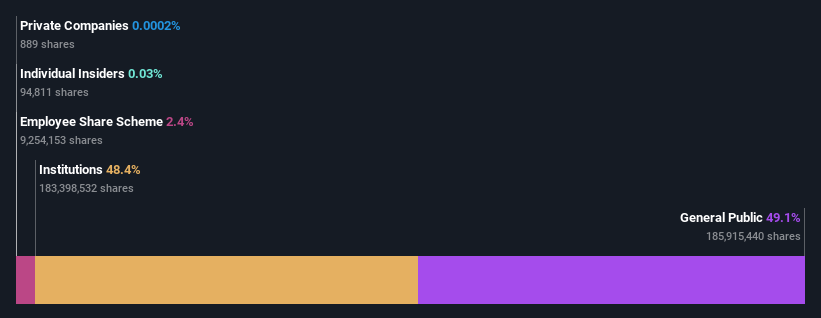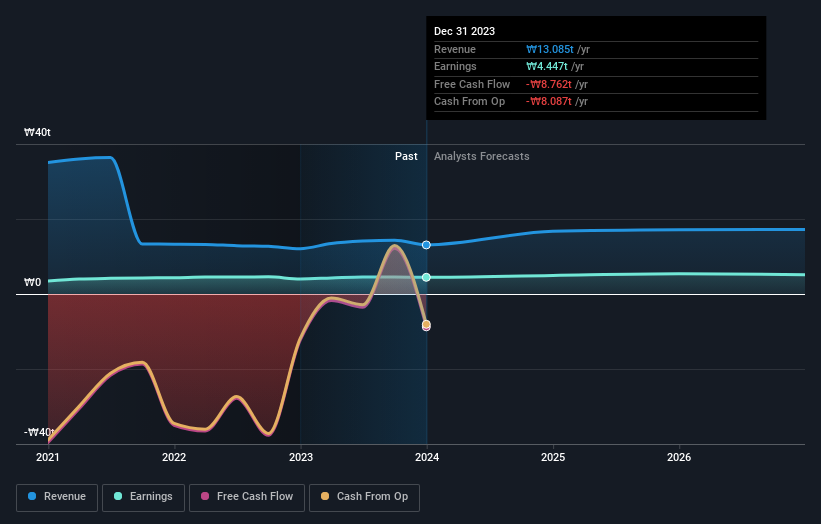- South Korea
- /
- Banks
- /
- KOSE:A105560
Both individual investors who control a good portion of KB Financial Group Inc. (KRX:105560) along with institutions must be dismayed after last week's 4.1% decrease

Key Insights
- KB Financial Group's significant individual investors ownership suggests that the key decisions are influenced by shareholders from the larger public
- 38% of the business is held by the top 25 shareholders
- 48% of KB Financial Group is held by Institutions
If you want to know who really controls KB Financial Group Inc. (KRX:105560), then you'll have to look at the makeup of its share registry. We can see that individual investors own the lion's share in the company with 49% ownership. Put another way, the group faces the maximum upside potential (or downside risk).
Following a 4.1% decrease in the stock price last week, individual investors suffered the most losses, but institutions who own 48% stock also took a hit.
In the chart below, we zoom in on the different ownership groups of KB Financial Group.
See our latest analysis for KB Financial Group

What Does The Institutional Ownership Tell Us About KB Financial Group?
Institutions typically measure themselves against a benchmark when reporting to their own investors, so they often become more enthusiastic about a stock once it's included in a major index. We would expect most companies to have some institutions on the register, especially if they are growing.
As you can see, institutional investors have a fair amount of stake in KB Financial Group. This can indicate that the company has a certain degree of credibility in the investment community. However, it is best to be wary of relying on the supposed validation that comes with institutional investors. They too, get it wrong sometimes. If multiple institutions change their view on a stock at the same time, you could see the share price drop fast. It's therefore worth looking at KB Financial Group's earnings history below. Of course, the future is what really matters.

We note that hedge funds don't have a meaningful investment in KB Financial Group. Our data shows that National Pension Service is the largest shareholder with 8.8% of shares outstanding. Meanwhile, the second and third largest shareholders, hold 6.7% and 3.7%, of the shares outstanding, respectively.
Our studies suggest that the top 25 shareholders collectively control less than half of the company's shares, meaning that the company's shares are widely disseminated and there is no dominant shareholder.
While it makes sense to study institutional ownership data for a company, it also makes sense to study analyst sentiments to know which way the wind is blowing. There are a reasonable number of analysts covering the stock, so it might be useful to find out their aggregate view on the future.
Insider Ownership Of KB Financial Group
The definition of company insiders can be subjective and does vary between jurisdictions. Our data reflects individual insiders, capturing board members at the very least. The company management answer to the board and the latter should represent the interests of shareholders. Notably, sometimes top-level managers are on the board themselves.
Insider ownership is positive when it signals leadership are thinking like the true owners of the company. However, high insider ownership can also give immense power to a small group within the company. This can be negative in some circumstances.
Our information suggests that KB Financial Group Inc. insiders own under 1% of the company. It is a very large company, so it would be surprising to see insiders own a large proportion of the company. Though their holding amounts to less than 1%, we can see that board members collectively own ₩6.3b worth of shares (at current prices). It is good to see board members owning shares, but it might be worth checking if those insiders have been buying.
General Public Ownership
With a 49% ownership, the general public, mostly comprising of individual investors, have some degree of sway over KB Financial Group. While this size of ownership may not be enough to sway a policy decision in their favour, they can still make a collective impact on company policies.
Next Steps:
While it is well worth considering the different groups that own a company, there are other factors that are even more important. Case in point: We've spotted 1 warning sign for KB Financial Group you should be aware of.
Ultimately the future is most important. You can access this free report on analyst forecasts for the company.
NB: Figures in this article are calculated using data from the last twelve months, which refer to the 12-month period ending on the last date of the month the financial statement is dated. This may not be consistent with full year annual report figures.
Valuation is complex, but we're here to simplify it.
Discover if KB Financial Group might be undervalued or overvalued with our detailed analysis, featuring fair value estimates, potential risks, dividends, insider trades, and its financial condition.
Access Free AnalysisHave feedback on this article? Concerned about the content? Get in touch with us directly. Alternatively, email editorial-team (at) simplywallst.com.
This article by Simply Wall St is general in nature. We provide commentary based on historical data and analyst forecasts only using an unbiased methodology and our articles are not intended to be financial advice. It does not constitute a recommendation to buy or sell any stock, and does not take account of your objectives, or your financial situation. We aim to bring you long-term focused analysis driven by fundamental data. Note that our analysis may not factor in the latest price-sensitive company announcements or qualitative material. Simply Wall St has no position in any stocks mentioned.
About KOSE:A105560
KB Financial Group
Provides a range of banking and related financial services to consumers and corporations in South Korea, the United States, New Zealand, China, Cambodia, the United Kingdom, Indonesia, and internationally.
Flawless balance sheet, undervalued and pays a dividend.
Similar Companies
Market Insights
Community Narratives




